These moments will be lost in the depressions & caverns of the human books forever, like, tears, in, pain, but the thoughts will be eternal. To explain the happiness is impossible ever for fate. its just a pure halcyon set to last more existences than a conceivable number. stupid gay nigger humans think im "crazy". or they think im childish. hahaha. because i cant solve S sin52xss3xdx. That makes me dumb! Because i cant stay thinking in a 2nd dimension, i go to the 5th! haha. so i wait 5 more days. 5 more days. 5 eternitys. & i know he & i are concieved from ourselves & each other. every night of the self-awareness journey, every thought we concieved, we have finished the race. time to die. everything we knew, we were able to understand it, to percieve it, into what we should, everything we knew, we know & use. an understanding of the everything. An einstein stuck in an ant's body. we are the nature of existence. the zombies were a test to see if our love was genuine. we are in wait of our reward, each other. the zombies will never cause us pain anymore. the humanity was a test. I love you, love. Time to die, time to be free, time to love
“I confess I do not believe in time. I like to fold my magic carpet, after use, in such a way as to superimpose one part of the pattern upon another. Let visitors trip. And the highest enjoyment of timelessness―in a landscape selected at random―is when I stand among rare butterflies and their food plants.- nabokov
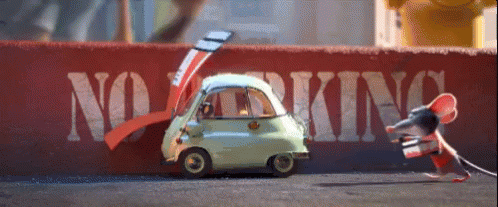
Wednesday, August 27, 2025
Wednesday, August 6, 2025
From Joseph Smith as scientist : a contribution to Mormon philosophy by Widtsoe, John Andreas, 1872-1952
Referring to the above diagrams it will be observed that although each arrangement contains the same number of atoms, yet, because of the difference in arrangement, they are far from being identical. In fact, the difference in the properties of the sugars may be referred to the arrangement of the atoms in the molecules. This truth is one of the most splendid achievements of modern science. All the facts, here briefly outlined, are included in the atomic hypothesis, which is the foundation of the modem science of chemistry.
Science asks us to believe in the existence of particles, unknowable to our senses, the molecules; Science requires then to believe in still smaller particles, fn^"thrngs^not *^® atoms, which make up the molecules seen." but whose relative weights and general properties have been determined. Here, a faith is required in "things that can not be seen," and in the properties of these things. True, the scientist does not pretend to describe the atoms in detail, he does not need to do that to establish the certainty of their existence. He looks upon them as ultimate causes of effects that he may note with his physical senses. Does theology require more ? Does any sane man in asking us to believe in God, for iastance, attempt to describe him in detail ?
The scientist goes farther than this, however, for he asks us not only to have faith in the invisible, untasteable, unfeelable atoms, but also in the exact manner in which these atoms are arranged within the molecule. True, it is claimed, only, that the relative arrangement is known, yet the faith required still leads us far beyond the simple faith, in atoms. Has any man asked us to believe that he can describe the structure of God's dwelling? No principle taught by Joseph Smith requires a larger faith than this.
Not only in chemistry are such transcendant truths required. The fundamental conception of physics requires, if possible, a larger faith. The explanations of modern physics rest largely upon the doctrine Of the universal ether. This ether is everywhere present, between the molecules and atoms; in fact the things of the universe are, as it were, suspended in the ocean of ether. This ether is so attenuated that it fills the pores of the human body without impressing itself upon our consciousness, yet some of its properties indicate that its elasticity is equal to that of steel. As shown in chapter 5, the most eminent scientists of the day declare that the existence of this world-ether is one of the few things of which men may be absolutely sure. Yet the ether cannot be seen, heard, tasted, smelled or felt. To our senses it has neither weight nor substance. To believe the existence of this ether requires a faith which is certainly as great as the greatest faith required by Mormon theology..
Numerous other illustrations might be cited, without greatly emphasizing the truth that the great fundamental doctrines of science require a great faith in realities that are beyond the reach of our senses.
faith. physics rest largely upon the doctrine
of the universal ether. This ether is everywhere present, between the molecules and atoms; in fact the things of the universe are, as it were, suspended in the ocean of ether. This ether is so attenuated that it fills the pores of the human body without impressing itself upon our consciousness, yet some of its properties indicate that its elasticity is equal to that of steel. As shown in chapter 5, the most eminent scientists of the day declare that the existence of this world-ether is one of the few things of which men may be absolutely sure. Yet the ether cannot be seen, heard, tasted, smelled or felt. To our senses it has neither weight nor substance. To believe the existence of this ether requires a faith which is certainly as great as the greatest faith required by Mormon theology.
Sunday, May 11, 2025
From Email to the Universe: and other alterations of consciousness
Email to the Universe: and other alterations of consciousness
Chapter 49: The Relativity of “Reality”
The Relativity of “Reality”
1. From the viewpoint of semantics, “reality” is a multi-ordinal concept, having different meanings on different levels of abstraction. On the lowest level of abstraction “reality” refers to immediate sensory consistency. “Is there really a kangaroo in that chair?” can be answered by obtaining the consensus of the group; or, if everybody is stoned, by bringing in some objective observers with objective instruments, etc. On the highest level of abstraction, “reality” refers to logical consistency with a body of established scientific fact and theory. “Is entropy real?” can be answered by consulting a reliable textbook on thermodynamics. Between the level of kangaroo and the level of entropy, there are many other levels of abstraction and, hence, many kinds of “reality.”
For instance, “Is the Gross National Product real?” is a question on a certain level of abstraction; and if equally intelligent people can, and do, argue about this, it is because they are talking on different levels of abstraction and are not aware of the fact that there are different levels of abstraction and different kinds of “reality.”
I call this the semantic relativity of “reality.”
2. Every tribe has its own “reality — map,” or worldview, or What is “real” to the Eskimo is not what is “real” to the Zuni Indian or the Congolese or the Japanese Buddhist or the German businessman or the Russian commissar, etc. If you travel around the world with the naive assumption that everybody is living in the same “reality,” you will make numerous embarrassing mistakes, insult countless people unintentionally, make a splendid ass of yourself and generally contribute to the worldwide belief that tourists are a Curse of God sent to punish people for their sins. To recognize that every culture, and sub-culture, has its own “reality” is the prerequisite of sophistication, tact, and true tolerance. Otherwise you come on like the Englishman who claimed all Chinese understand English if you just shout loud enough.
I call this the anthropological, or cultural, relativism of “reality.”
3. Every nervous system creates its own “reality.” Out of the billions, or billions of billions, of energies intersecting the room in which you read this, your brain, performing 100,000,000 processes per minute (almost all of them unconscious to those circuits called the ego and recognized as “me”) arranges a few hundred or thousand into the Gestalt which you experience as the “reality” of the room. To demonstrate this, in my Info-Psychology classes, I will have the students describe the hall outside the lecture room; no two will describe exactly the same hall.
Or, I will have everybody write down what they hear in the room during a minute of clock-time; no two lists of these sounds will be identical. A variety of chemicals introduced into the nervous system, or direct brain stimulation with electrical impulses, or yoga, etc., will create an entirely different neurological “reality” while you are still sitting in the "same” room.
I call this neurological relativism, or the relativity of perceived “reality.”
4. Two scientists moving at different accelerations can measure the same phenomenon with equally accurate instruments and obtain totally different readings of its extensions in the space and time dimensions. (Einstein, Special On the quantum level, a variety of different philosophical reality-maps, or “models,” describe equally well both the experimental data and the mathematical equations that are known to “fit” the data. Any attempt to get around this by adding more sophisticated instruments leads to adding still more sophisticated instruments to monitor the first set, and so on, forever. (Von Neumann’s “catastrophe of the infinite regress.”)
I call this physical Relativity, or the relativity of instrumental “reality.”
In conclusion, “reality” is a concept borrowed from the theologians who, being bankrupt, are in no position to loan anything to anybody. We would do better to restrict ourselves to questions that can be answered. Such questions take the form, “At this date, with the knowledge presently possessed by humanity, which model best accords with the facts?”
When it turns out, as it usually does these days, that several models work equally well, we might then ask: which models are most amusing? most optimistic? most worthy of our time and energy? most elegant and esthetic? And we can keep in mind, too, biologist J.B.S. Haldane’s warning, “The universe may be not only stranger than we think, but stranger than we can think.”
Friday, May 2, 2025
Thursday, April 17, 2025
Tell Me a Fractal Geoffrey DuttonMay 17, 20225 minute read
“What I hope this book now will leave behind: the idea that new patterns like spirals or explosions or vortex streets might open our eyes to other natural shapes underlying our stories, might let us step away from the arc sometimes, slip under or through that powerful wave, glorious as it can be. I hope that other patterns might help us imagine new ways to make our narratives vital and true, keep making our novels novel.”
Jane Alison, Meander, Spiral, Explode: Design and Pattern in Narrative, Catapult, 2018, pages 248-9.
Think of a snowflake forming around a molecule of water clinging to a tiny particle of something, how it blossoms and diverges as other molecules join in, seeking their hexagonal destiny, becoming a perfect thing of beauty. Then think of it melting, its sharp edges blurring, its interstices blotting out until it plops to earth. That’s a story, right there, in full surround. Matter, space and time at play.
The last two sentences in Jane Alison’s brief book, quoted above, hint at a broader range of spatial patterns that authors she discusses have deployed in fiction. She sees fractals, meanders, networks and other geometric structures as literary armatures that can supplant or coexist with the conventional Aristotelian beginning-middle-end story arc.
Ever since its publication, I’ve considered starting a sequel to my novel Turkey Shoot but felt stymied because no plot seemed to gel. I had what could be its central protagonist and vague ideas about her situation, but no idea what ought to happen, or even a location or time frame for the story. Perhaps, I thought upon reading Alison’s approach to story craft, I should think different. Meander, Spiral, Explode might help me wend my way around my writer’s block.
But how to build spatial metaphors into my nascent novel in an organic way, not as literary gimmicks? They could, I hoped, serve as scaffolding for expressing themes across different locals, scenes, characters, and subplots, on which to build a narrative structure in the fullness of space-time. Embracing spatial metaphors and analogs might prevent me from rolling out a story like a reel of audiotape.
A tape player (remember them?) has two rotating reels, one full and one empty to begin with. In between them sits a component called a “head” that “reads” electrical patterns on the tape as it is drawn at a steady pace by the “take-up” reel, just as we read by flipping pages of a book from one side to the other.
Sounds and images on tape unwind. Wound up, a tape forms a spiral and a book a stack whose narrative generally obeys Aristotle’s poetics but doesn’t need to. You can lose yourself in a book or a tape, but should you skip around in it you may get lost and fragment the experience. But instead of static tape heads, suppose readers were higher-dimensional beings able to leap along the spiral or radially to other tracks. In fact, many novels take readers back and forth through time space. You can think of a work of music or literature as a matrix of content that only seems to move and change because you navigate sequentially through it. Be it a story or a symphony, its creator ought to contrive that experience by elaborating themes with an architecture that gives delight.
Any of the structures that Alison cribs from geometry—she explores waves, wavelets, meanders, spirals, explosions, networks, fractals, and tsunamis—can be metaphorically deployed as literary devices in a novel or even a short story, probably in poetry too. Take snowflakes, which are both “explosions” and “fractals,” forms that authors whose prose she deconstructs seem to have analogized in narratives. Explosions, such as events from which many consequences radiate, are not uncommon. Fractals are harder to write and recognize in prose. Mathematical fractals[1] are “self-similar” objects generated from a seed that replicates into a mosaic-like pattern through time and space and across scales; as you zoom in or out, you see more of the same thing in every nook and cranny.
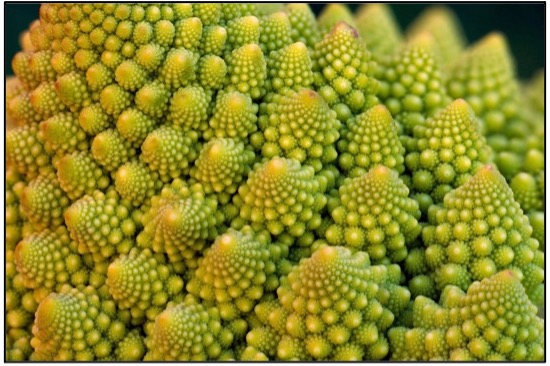
Fractals aren’t just equations. Forces of nature spontaneously generate all sorts of them. True to themselves, snails and sunflowers spiral, rivers and trees branch, coastlines and mud flats crinkle. But how many works of literature manifest such holistic qualities beyond displaying a consistent, self-similar style? To evoke them in writing seems difficult and perhaps unnatural, but it’s possible. Jane Alison believes David Mitchell’s Cloud Atlas is somewhat fractal; she also sees in it a tsunami. It’s a set of stories structured with palindromic symmetry—12345654321: “six long stories, one nested in the next” that “run from the 1850s into a shattered far future, and each story features someone who is weak and others who are monstrously powerful.” The first five are revisited in reverse order following the central futuristic one, “the only one told whole.” But each of its “cells,” she writes, “has its own texture and colors, and each makes the same sort of moves.”
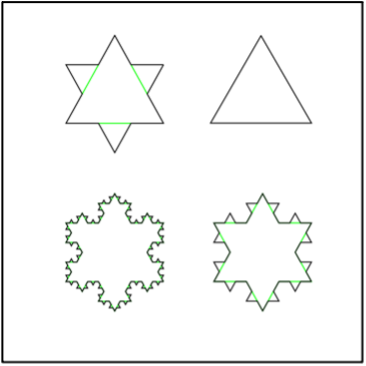
Turkey Shoot has few fractal qualities. But that doesn’t mean that a sequel need follow suit. It could ramify like a Koch snowflake, successively elaborating a simple shape to generate more intricate narrative detail. For example, consider a multigenerational family saga in which each cohort recapitulates or elaborates stories of those who have gone before.
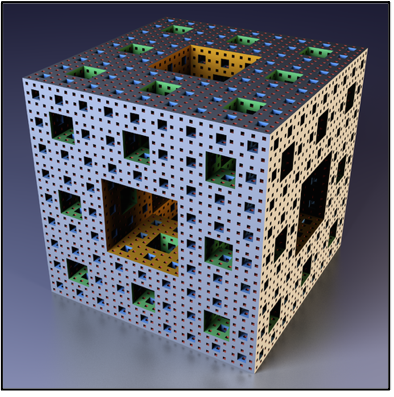
Or, like a Menger Sponge, a narrative could hollow out a prism of space-time with similar adjacent incidents, densifying until they almost merge. Think how an edict issuing from an outside power, say a central bank demanding austerity measures, can erode a nation-state. Its central bank is hit first, successively afflicting provinces, cities and then neighborhoods, families, and individuals. What was writ large comes home to roost.
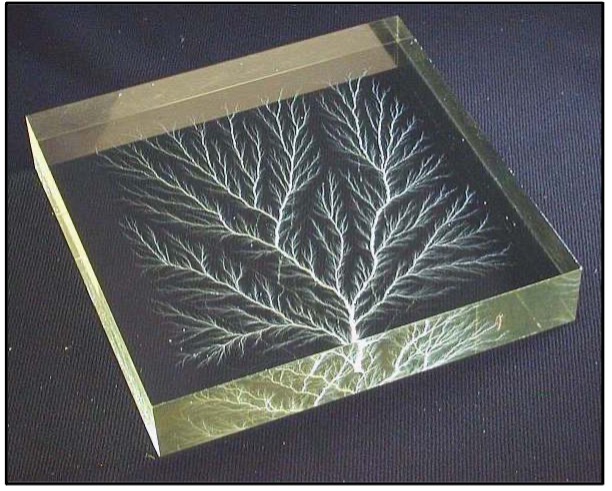
Draining static electricity from the base of an acrylic block sculpted this lacy fractal. These Lichtenberg figures branch just as trees, rivers, and blood vessels do to efficiently convey nutrients. Now consider nutrients as thoughts from different origins converging into ideas, or utterances meeting to form conversations. They continue to merge with others, building larger and larger narratives. Interactions at branching points are one-way or two-way dialogs between partners, friends, strangers, or enemies that can be friendly, casual, formal, or heated. Imagine an account of a horde of cops busting a street demonstration, each seizing a protester, corralling them in small groups that they hustle into a paddy wagon that drops them at a holding pen to join other captured protesters. That’s just how rivers channel precipitation.
I don’t know if I’ll pull off that novel or not, but I’m more likely to try having read Meander, Spiral, Explode. If you’ve been struggling to write a story, collection, or novel, pick up a copy and see where its patterns take your imagination.
Thursday, March 27, 2025
The Box is a bit like The Matrix.
The Box is a bit like The Matrix.
What The Box essentially represents is the societal paradigm of a structured ‘life existence’ framework. Within the confines of The Box’s parameters, he defines the present, limited human hierarchical order in this this current existence. Yes, I know that was a mouthful – sorry about that but bear with me. 😉
Inside of the large ‘Existence Box’ there is a division of boxes within boxes. Dylan further defines a total of four box subset groups as the “limitations”. Each is a box within a box spanning outward smallest to largest in space. The smallest box being the most densely populated and each consecutive one has acquires larger space yet becomes more sparsely populated. Even though all boxes are encompassed under one large box (of Existence), Dylan points out that there is ‘limitation’ as each is a group divided from the other: inclusive to those within each box and exclusive to those outside of each box. The first box is densely populated and labeled “Most” but it’s also the smallest box. In short, it includes many but it’s small in space. This signifies that the acceptable majority within society are also the most select, exclusive group and tucked away within the corner of the box almost as if it’s harder to obtain that special, designated space. There are many within it but it will only hold, or include, so many citizens that are ‘lucky’ enough to be deemed a part of it’s community. It is also the smallest box in the literal sense because it represents the small minded sorts that rely on thinking inside the box at the most limited, confining sense of existence. Spanning out from the smallest, elite “Most” box is the larger box defined as “Some”. This grouping is next in line to have a sense of belonging in a fairly acceptable existence group yet the box is a bit larger, less crowded (like the cattle or herd of “Most” )and more liberal in space but also in terms of societal rules and regulations. Outside of “Some”, are the “Few”. This third box essentially represents ‘the outcasts’ category from the two previous acceptable degrees of the societal majority. The “Some” have a esser sense of community or belonging here inside “Existence” but it’s also a larger box and containing the free-thinker, the unconventional citizens embracing less acceptable liberal minded views to that of the herd mentality of the “Most/Few” society. While the ‘Some’ are misfits they have their own opposing brand of ‘special’ to the elite “Most”; they are unique individualists that think for themselves and do not follow the masses. They do not need a mass of others to set the rules and help define them. Outside the “Few” is the vast box of “None” which represents…..no one… it is the no man’s land of “the nobodies”, the “nothings” , the bottom-of-the-barrel losers of society that don’t even amount to a mere blip on the radar of human societal existence.
Sunday, March 2, 2025
Time, Space, & THOUGHT
Within the known limits of time… within the conceived boundaries of space…. the average human thinks those are the settings of existence… Yet the ponderer, the outcast, the believer, helps out the human. “Think not of 2 dimensions,” says the ponderer, “but of 3, as your world is conceived of 3 dimensions, so is mine. While you explore the immediate physical boundaries of your body, you see in your 3 dimensions—L, W, & H. Yet I, who is more mentally open to anything, see my 3 dimensions, my realm of thought—Time, Space, & THOUGHT. Thought is the most powerful thing that exists—anything conceivable can be produced, anything & everything is possible, even in your physical world.” After this so called “lecture” the common man feels confused, empty, & unaware. Yet those are the best emotions of a ponderer. The real difference is, a true ponderer will explore these emotions & what caused them. Another… a dream.
Wednesday, May 10, 2023
“I confess I do not believe in time
“I confess I do not believe in time. I like to fold my magic carpet, after use, in such a way as to superimpose one part of the pattern upon another. Let visitors trip. And the highest enjoyment of timelessness―in a landscape selected at random―is when I stand among rare butterflies and their food plants. This is ecstasy, and behind the ecstasy is something else, which is hard to explain. It is like a momentary vacuum into which rushes all that I love. A sense of oneness with sun and stone. A thrill of gratitude to whom it may concern―to the contrapuntal genius of human fate or to tender ghosts humoring a lucky mortal.”
― Vladimir Nabokov-
A commandment Vasyl Sagaydak 1990 Never let a barbarian on your doorstep, my son – No matter if he comes with war or with sweet vows. He w...
-
Certificate of Live Birth Jasmine Reid You arrive on a Friday, with hail & vast moving grey above small window of white light, as a wo...

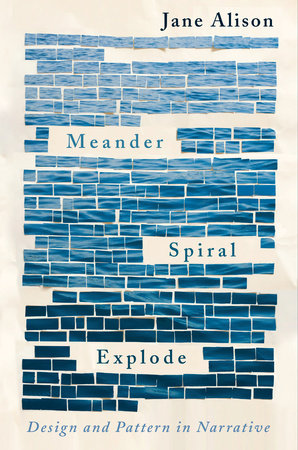
.png)